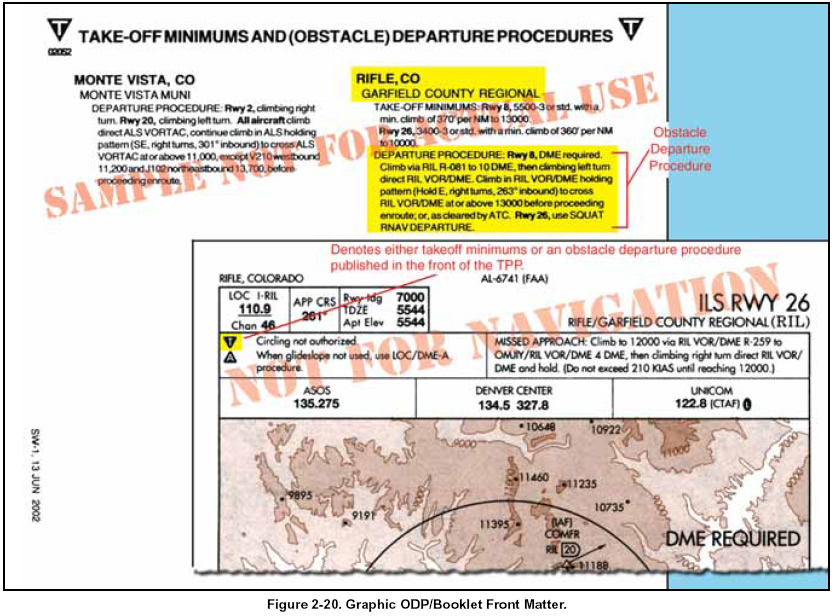 |
|
| INSTRUMENT PROCEDURES HANDBOOK |
|
OBSTACLE DEPARTURE PROCEDURES The term Obstacle Departure Procedure (ODP) is used to define procedures that simply provide obstacle clearance. ODPs are only used for obstruction clearance and do not include ATC related climb requirements. In fact, the primary emphasis of ODP design is to use the least onerous route of flight to the en route structure or at an altitude that allows random (diverse) IFR flight, while attempting to accommodate typical departure routes. An ODP must be developed when obstructions penetrate the 40:1 departure OCS, using a complex set of ODP development combinations to determine each situation and required action. Textual ODPs are only issued by ATC controllers when required for traffic. If they are not issued by ATC, textual ODPs are at the pilot’s option to fly or not fly the textual ODP, even in less than VFR weather conditions, for FAR Part 91 operators, military, and public service. As a technique, the pilot may enter “will depart (airport) (runway) via textual ODP” in the remarks section of the flight plan, this information to the controller clarifies the intentions of the pilot and helps prevent a potential pilot/controller misunderstanding. ODPs are textual in nature, however, due to the complex nature of some procedures, a visual presentation may be necessary for clarification and understanding. Additionally, all newly developed area navigation (RNAV) ODPs are issued in graphic form. If necessary, an ODP is charted graphically just as if it were a SID and the chart itself includes “Obstacle” in parentheses in the title. A graphic ODP may also be filed in an instrument flight plan by using the computer code included in the procedure title. Only one ODP is established for a runway. It is considered to be the default IFR departure procedure and is intended for use in the absence of ATC radar vectors or a SID assignment. ODPs use ground based NAVAIDS, RNAV, or dead reckoning guidance wherever possible, without the use of radar vectors for navigation. Military departure procedures are not handled or published in the same manner as civil DPs. Approval authority for DPs at military airports rests with the military. The FAA develops U.S. Army and U.S. Air Force DPs for domestic civil airports. The National Geospatial-Intelligence Agency (NGA) publishes all military DPs. The FAA requires that all military DPs be coordinated with FAA ATC facilities or regions when those DPs affect the NAS. All ODP procedures are listed in the front of the NACO approach chart booklets under the heading Takeoff Minimums and Obstacle Departure Procedures. Each procedure is listed in alphabetical order by city and state. The ODP listing in the front of the booklet will include a reference to the graphic chart located in the main body of the booklet if one exists. Pilots do not need ATC clearance to use an ODP and they are responsible for determining if the departure airport has this type of published procedure. [Figure 2-20]
FLIGHT PLANNING CONSIDERATIONS During planning, pilots need to determine whether or not the departure airport has an ODP. Remember, an ODP can only be established at an airport that has instrument approach procedures (IAPs). An ODP may drastically affect the initial part of the flight plan. Pilots may have to depart at a higher than normal climb rate, or depart in a direction opposite the intended heading and maintain that for a period of time, any of which would require an alteration in the flight plan and initial headings. Considering the forecast weather, departure runway, and existing ODP, plan the flight route, climb performance, and fuel burn accordingly to compensate for the departure procedure. Additionally, when close-in obstacles are noted in the Takeoff Minimums and (Obstacle) Departure Procedures section, it may require the pilot to take action to avoid these obstacles. Consideration must be given to decreased climb performance from an inoperative engine or to the amount of runway used for takeoff. Aircraft requiring a short takeoff roll on a long runway may have little concern. On the other hand, airplanes that use most of the available runway for takeoff may not have the standard ROC when climbing at the normal 200 feet per NM. Another factor to consider is the possibility of an engine failure during takeoff and departure. During the preflight planning, use the aircraft performance charts to determine if the aircraft can still maintain the required climb performance. For high performance aircraft, an engine failure may not impact the ability to maintain the prescribed climb gradients. Aircraft that are performance limited may have diminished capability and may be unable to maintain altitude, let alone complete a climb to altitude. Based on the performance expectations for the aircraft, construct an emergency plan of action that includes emergency checklists and the actions to take to ensure safety in this situation.
|
